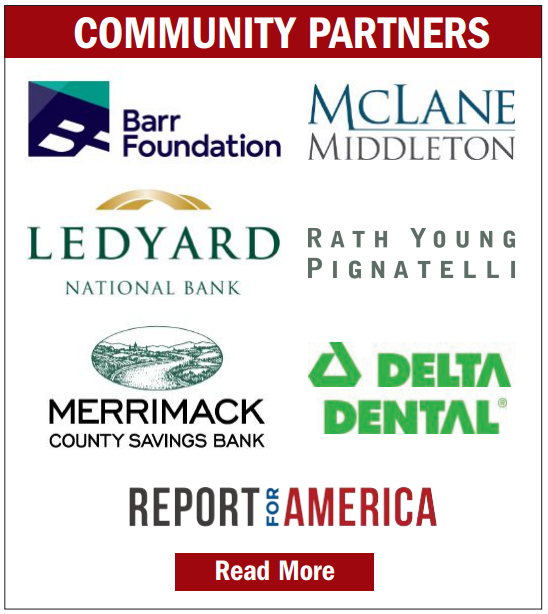Boscawen’s Commercial Street revitalization kicks off as residents share their visions for new housing and a restaurant
| Published: 02-01-2025 8:01 AM |
When Boscawen resident Loren Martin imagines the future of the town’s Commercial Street, she can picture a multi-story building with a restaurant on the ground floor, affordable apartments in the middle, and a rooftop deck to grab a drink overlooking the Contoocook River at the top.
“Something like that brings the best bang for our buck as far as meeting all the needs but also increasing that tax base,” said Martin during a meeting this week in which the town unveiled a series of options for transforming a 19-acre crop of land on the street.
Thursday’s meeting came as residents prepare to vote in March’s town meeting on whether to designate the area a tax increment financing district, which grows the town’s tax base while offering incentives to potential developers to reinvest into the area.
A portion of the street, which used to house a number of mills, has fallen into disrepair since one of the buildings of the former Allied Leather Tannery burned down in 2002. The town acquired the property in 2009 and in recent years secured a $500,000 grant to aid in cleaning up the area. The remaining buildings were demolished in 2022.
In a town that has been lauded for prioritizing new housing, Boscawen leaders and employees have framed the Commercial Street project as a way to both develop more housing and to revitalize a street with environmental and infrastructure needs.
“To me, this is the most valuable area of town we have in terms of … future value,” Select Board Chair Lorrie Carey said.
Town leaders and consultants from the development firm Vita Nuova sought feedback on six options for the space, which range from building a trailhead for the adjacent Northern Rail Trail, which would cost approximately $100,000, to the mixed-use option Martin favored, which would cost an estimated $5 million, according to the presentation.
An architect estimated that option could fit 16 or so 1,100-square-foot apartments, along with 5,000-square-feet of retail space.
Article continues after...
Yesterday's Most Read Articles
 Facing 30% budget cut, university leaders say raising tuition is not an option
Facing 30% budget cut, university leaders say raising tuition is not an option
 One year after UNH protest, new police body camera footage casts doubt on assault charges against students
One year after UNH protest, new police body camera footage casts doubt on assault charges against students
 ‘It’s always there’: 50 years after Vietnam War’s end, a Concord veteran recalls his work to honor those who fought
‘It’s always there’: 50 years after Vietnam War’s end, a Concord veteran recalls his work to honor those who fought
 A city for coffee lovers: Northeast Coffee Festival returning to Concord this weekend
A city for coffee lovers: Northeast Coffee Festival returning to Concord this weekend
 New Hampshire State Police join ICE task force
New Hampshire State Police join ICE task force
 25-year-old man shot by police in Keene, AG investigating
25-year-old man shot by police in Keene, AG investigating
The other options included building six single-family homes for a total of $1.9 million and 15 townhouses for a total of $4.8 million – or some mixture of townhouses and retail space.
Those options did not get a lot of support, both out of concern that they would be too expensive to satisfy the need for affordable housing and because of a desire for a space all town residents could use.
“It should be more of a commercial or public area so that people could go to a restaurant or have a pizza or have a hot dog or whatever,” Sue Porter said.
The area poses certain topographic challenges that limit the building options: it slopes down to the river and is encompassed by a flood plane. Those issues prompted some discussion about whether the paved portion of the street could be relocated to create more usable building space.
The timeline for a decision on what to build and how long the process will take is not clear yet. Following the vote on the establishment of the TIF district in March, the town will have until September 2026, according to the terms of its grant, to finish the clean up process.
It is also not clear exactly how the project would affect Boscawen’s tax revenue.
An estimate that relies on the development of 163 residential units – far more than the 16 anticipated under the largest plan presented Thursday – would draw an additional estimated $870,00 per year in tax revenue for the town, according to the TIF plan.
Jeremy Margolis can be contacted at jmargolis@cmonitor.com.









 Outside, please: Concord outdoor dining begins for the season
Outside, please: Concord outdoor dining begins for the season ‘A full board’: After frustration, Chichester appoints a third selectman
‘A full board’: After frustration, Chichester appoints a third selectman Patriot Piecemakers craft quilts to honor veterans
Patriot Piecemakers craft quilts to honor veterans From raising chickens to programming a VR game, Merrimack Valley High School students show off their senior projects
From raising chickens to programming a VR game, Merrimack Valley High School students show off their senior projects
